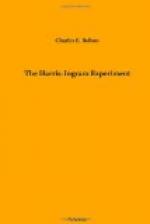Gertrude and George had read Scott’s novel in which he tells of the ancient glories of Kenilworth, which dates back to the twelfth century, and to-day is considered the most beautiful ruin in the world. Ivy mantles the lofty ruined walls; the sun tinges in silver the gray old towers, and sends a flood of golden light through the deep windows of the once magnificent banqueting hall.
For years Kenilworth Castle was a royal residence, and later it was the scene of bloody conflicts between kings and nobles. Today sheep peacefully graze within the ruins and about the grounds. Visitors from all parts of the world look in wonder upon the decay of glories that once dazzled all Europe. Here the earl of Leicester entertained his virgin queen hoping to marry her. As Elizabeth crossed the draw-bridge a song in her praise was sung by a Lady of the Lake on an island floating in the moat. Story writers have never tired of telling of the magnificence of these entertainments that cost the ambitious earl $20,000 per day for nineteen days.
Returning, Warwick Arms Hotel was reached for lunch, after which the party drove eight miles to Stratford-on-Avon, a model town on the classic Avon. Here in Henley Street, in a half-timbered house recently carefully restored, Shakespeare was born. The walls and window panes are covered with the names of visitors, while inside are kept albums for the autographs of kings, queens, of Scott, Byron, Irving, and others. One of the three rooms below is an ancient kitchen, where by the big open chimney the poet often sat. Climbing a winding, wooden stairway, George and Gertrude in the lead, our Harrisville friends entered the old-fashioned chamber, where, it is said, on St. George’s Day, April 19, 1564, William Shakespeare was born. A bust of the poet stands on the table.
“We know little of his mother,” said Gertrude, “except that she had a beautiful name, Mary Arden. If it is true, as a rule, that all great men have had great mothers, Mary Arden must have been a very superior woman.”
“The reverse, Gertrude, must be equally true,” said George, “that all great women must have had great fathers.”
Gertrude who had made a special study of Shakespeare and his works did much of the talking. She said, “All that is definitely known of the life of the great poet can be put on half a page. It is thought that William was the son of a well-to-do farmer who lost his property. William, not above work, assisted his father as butcher, then taught school, and later served as a lawyer’s clerk. When he was eighteen, like most young people, he fell in love.”
Saying this, Gertrude led to the street, and the party drove to Shottery, a pretty village a mile away, where is Ann Hathaway’s thatched cottage. “Here the beardless William often came,” said Gertrude, “and told his love to the English maiden. Ann Hathaway was older than William, she was twenty-six, but they were married, and had three children.




